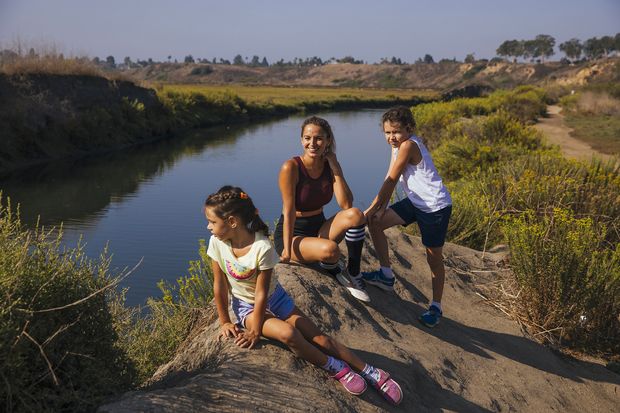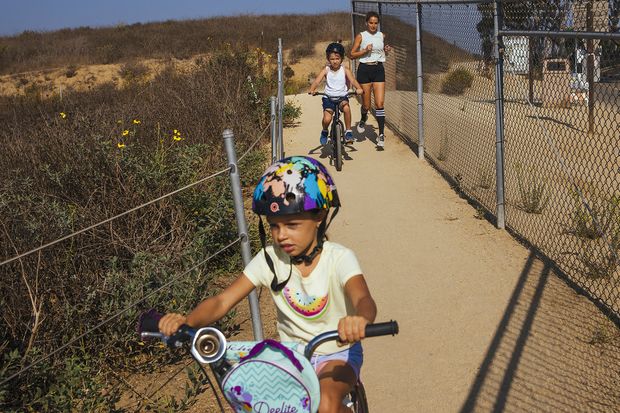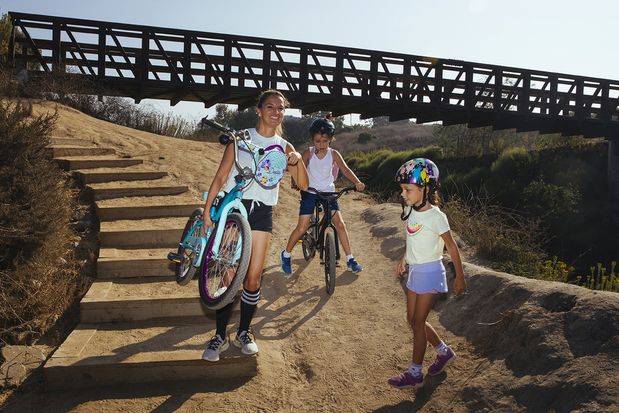
Amy Parvaneh used to rely on her SoulCyle instructor for motivation. Now, her two children are the ones on the bikes, encouraging her to push through the pain of her new sport, running.
“When my kids are yelling, ‘Mom, you can do it,’ there’s no way I can let them down,” she says. “I might be sweating buckets, but I’m getting up that hill.”
Ms. Parvaneh, 41, is a single parent and helps care for her retired parents who live next door. As the founder and CEO of Select Advisors Institute, an Irvine, Calif.-based sales coaching and marketing consulting agency to financial organizations, she has long relied on exercise to alleviate stress and calm her mind.

During the pandemic, Ms. Parvaneh started running after her kids, Hudson Scotti, 9, and Valentina Scotti, 6, while they biked.
Pre-pandemic, she estimates she spent $1,000 a month between SoulCycle, hot yoga and her gym membership. She spent an additional $600 a month on tennis, dance and taekwondo lessons for her kids, Hudson Scotti , 9, and Valentina Scotti , 6. “When Covid hit and everything closed, we felt trapped,” she says. “I needed exercise to fuel my brain.” She tried doing yoga at home, but says not going outside frustrated her. “It felt like a day of never-ending work and schooling,” she says.
In late March, she piled her kids and their two bikes into her two-door car, drove from her home in Newport Beach, Calif., to a trailhead and told them, “Start riding.” She chased after them. “They cried and screamed. But now they actually look forward to it,” she says. “And I hated running. I don’t think I’d run 1 mile in years.” Ms. Parvaneh says her runs have given her time to reflect on new work projects and strategies, and come up with fresh business ideas.
The family has logged over 300 miles together. Ms. Parvaneh says combining workouts has been more affordable and efficient, and the family is spending more time together. She doesn’t plan to restart her fitness memberships post-pandemic. “It’s been a great bonding experience,” she says.

Valentina takes the lead while Hudson keeps pace with Ms. Parvaneh on a trail in the Upper Newport Bay Nature Preserve.
The Workout
The family hits the trails Monday, Wednesday and Saturday. Ms. Parvaneh says it would be easier to run along the beach or on the Pacific Coast Highway, but she’s been trying to find less crowded routes. They typically use the upper section of the Newport Beach Back Bay Trail. “It is very hilly,” she says. “Every run we try to go one hill further.”
Share Your Thoughts
How much does exercising with a friend or family member help you get the workout you need? Join the conversation below.
She says mornings can be tough because there’s so much to handle with work and home schooling, and by late afternoon everyone is exhausted and wants to relax. Despite the midday heat, she finds noon or 1 p.m. her ideal workout window. “It helps us all reset for the second part of the day,” she says. “When I’m packing the car to hit the trail, I’m usually thinking, ‘How am I going to run 5 miles?’ But when I finish I feel like I can conquer the world.”
Ms. Parvaneh now considers herself a runner. She’s worked up to 6 miles and is looking to conquer 7. In September, smoke from the fires in California forced them to skip their first outdoor workout. “We turned to YouTube yoga videos,” she says. They’ve gotten back outside, but Ms. Parvaneh says she monitors the air-quality index closely.

Ms. Parvaneh and her children have logged over 300 miles of outdoor biking and running together since March.
The Basics
Dietary philosophy: “We eat clean: protein, olive oil, vegetables, pasta,” she says.
Home Cooking: “It would make life easier to order in, but cooking is my meditation,” she says.
Morning energy: “A smoothie of fresh fruits and vegetables and two scoops of peanut butter fills me up through 2 p.m.,” Ms. Parvaneh says.
Splurge: A glass of red wine with dinner.
Post-run fuel: “I cannot survive without a Diet Coke right after my runs,” she says. “It is a must and gets me ready for the second half of my day.”
Essential Gear: The family blasts music from a COMISO portable Bluetooth speaker ($30). “We sound like a party passing by,” she says.
Playlist: Sets from Burning Man.
Take Care When the Air Quality Drops
Unprecedented wildfires across the western U.S. have caused the air quality to plummet in nearby communities, forcing exercise enthusiasts to reconsider outdoor workouts.
Dr. Reza Ronaghi , an L.A.-based pulmonologist at UCLA Health, recommends staying indoors as much as possible during fire season and regularly checking the air quality. “Your nose and eyes do not do a good job at predicting air quality,” he says. “It might not look hazy or smell like smoke outside, but smoke contains fine microparticles invisible to the eye and they are detrimental to the lungs.” And it doesn’t matter if you’re walking or sprinting, exposure is exposure, he says.
For the average healthy adult, exposure once or twice a year won’t lead to long-term health damage, he says. You might experience short-term discomfort like a sore throat, watery eyes, runny nose or chest tightness, he says. People with pre-existing respiratory conditions like asthma or lung disease risk exacerbating those conditions.
The air quality index, or AQI, is measured on a scale of 0 to 500. Anything over 300 represents hazardous air quality, he says.
You can check air-quality conditions for a particular area on AirNow, a U.S. government website. He also suggests checking your local news reports.
What’s your workout? Tell us at workout@wsj.com
Copyright ©2020 Dow Jones & Company, Inc. All Rights Reserved. 87990cbe856818d5eddac44c7b1cdeb8